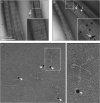How bacteria hack the matrix and dodge the bullets of immunity
- PMID: 29950304
- PMCID: PMC9488709
- DOI: 10.1183/16000617.0018-2018
How bacteria hack the matrix and dodge the bullets of immunity
Abstract
Haemophilus influenzae, Moraxella catarrhalis and Pseudomonas aeruginosa are common Gram-negative pathogens associated with an array of pulmonary diseases. All three species have multiple adhesins in their outer membrane, i.e. surface structures that confer the ability to bind to surrounding cells, proteins or tissues. This mini-review focuses on proteins with high affinity for the components of the extracellular matrix such as collagen, laminin, fibronectin and vitronectin. Adhesins are not structurally related and may be lipoproteins, transmembrane porins or large protruding trimeric auto-transporters. They enable bacteria to avoid being cleared together with mucus by attaching to patches of exposed extracellular matrix, or indirectly adhering to epithelial cells using matrix proteins as bridging molecules. As more adhesins are being unravelled, it is apparent that bacterial adhesion is a highly conserved mechanism, and that most adhesins target the same regions on the proteins of the extracellular matrix. The surface exposed adhesins are prime targets for new vaccines and the interactions between proteins are often possible to inhibit with interfering molecules, e.g heparin. In conclusion, this highly interesting research field of microbiology has unravelled host-pathogen interactions with high therapeutic potential.
Copyright ©ERS 2018.
Conflict of interest statement
Conflict of interest: None declared.
Figures



Comment in
- doi: 10.1183/16000617.0040-2018
Similar articles
-
Complement evasion by the human respiratory tract pathogens Haemophilus influenzae and Moraxella catarrhalis.FEBS Lett. 2020 Aug;594(16):2586-2597. doi: 10.1002/1873-3468.13758. Epub 2020 Mar 9. FEBS Lett. 2020. PMID: 32053211 Review.
-
The Respiratory Pathogen Moraxella catarrhalis Targets Collagen for Maximal Adherence to Host Tissues.mBio. 2016 Mar 22;7(2):e00066. doi: 10.1128/mBio.00066-16. mBio. 2016. PMID: 27006460 Free PMC article.
-
Use of the Chinchilla model to evaluate the vaccinogenic potential of the Moraxella catarrhalis filamentous hemagglutinin-like proteins MhaB1 and MhaB2.PLoS One. 2013 Jul 2;8(7):e67881. doi: 10.1371/journal.pone.0067881. Print 2013. PLoS One. 2013. PMID: 23844117 Free PMC article.
-
PRELP Enhances Host Innate Immunity against the Respiratory Tract Pathogen Moraxella catarrhalis.J Immunol. 2017 Mar 15;198(6):2330-2340. doi: 10.4049/jimmunol.1601319. Epub 2017 Feb 1. J Immunol. 2017. PMID: 28148731
-
Host-pathogen interactions of nontypeable Haemophilus influenzae: from commensal to pathogen.FEBS Lett. 2016 Nov;590(21):3840-3853. doi: 10.1002/1873-3468.12351. Epub 2016 Aug 25. FEBS Lett. 2016. PMID: 27508518 Review.
Cited by
-
Adhesion of anaerobic periodontal pathogens to extracellular matrix proteins.Braz J Microbiol. 2020 Dec;51(4):1483-1491. doi: 10.1007/s42770-020-00312-2. Epub 2020 Jun 17. Braz J Microbiol. 2020. PMID: 32557245 Free PMC article. Review.
-
Impact of low molecular weight heparin administration on the clinical course of the COVID-19 disease.Turk J Med Sci. 2021 Feb 26;51(1):28-38. doi: 10.3906/sag-2006-184. Turk J Med Sci. 2021. PMID: 32892540 Free PMC article.
-
Haemophilus parasuis VtaA2 is involved in adhesion to extracellular proteins.Vet Res. 2019 Sep 23;50(1):69. doi: 10.1186/s13567-019-0687-2. Vet Res. 2019. PMID: 31547880 Free PMC article.
-
Review of Label-Free Monitoring of Bacteria: From Challenging Practical Applications to Basic Research Perspectives.Biosensors (Basel). 2022 Mar 22;12(4):188. doi: 10.3390/bios12040188. Biosensors (Basel). 2022. PMID: 35448248 Free PMC article. Review.
-
Collagen Binding Proteins of Gram-Positive Pathogens.Front Microbiol. 2021 Feb 5;12:628798. doi: 10.3389/fmicb.2021.628798. eCollection 2021. Front Microbiol. 2021. PMID: 33613497 Free PMC article. Review.
References
-
- Kuusela P. Fibronectin binds to Staphylococcus aureus. Nature 1978; 276: 718–720. - PubMed
-
- Widdicombe JH, Bastacky SJ, Wu DX, et al. . Regulation of depth and composition of airway surface liquid. Eur Respir J 1997; 10: 2892–2897. - PubMed
-
- Wang Z, Bafadhel M, Haldar K, et al. . Lung microbiome dynamics in COPD exacerbations. Eur Respir J 2016; 47: 1082–1092. - PubMed
Publication types
MeSH terms
Substances
LinkOut - more resources
Full Text Sources
Other Literature Sources
Research Materials
